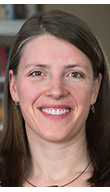Annual college symposium showcased faculty research

Carrie Dossick

Gina Neff
Related Story:
[Symposium keynote speakers ]
(http://one.arch.tamu.edu/news/2015/10/5/symposium-keynote-speakers/)
The Texas A&M College of Architecture’s 17th annual faculty research symposium, “Natural, Built, Virtual,” took place Oct. 19, 2015 at the Langford Architecture Center on the Texas A&M College Station campus.
The daylong event showcased college faculty research on issues relevant to the natural, built and virtual environments in a series of fast-paced lectures abbreviated from talks previously delivered at scholarly gatherings around the world. The 2015 symposium included invited or refereed presentations and papers from the 2014-15 academic year.
"The individual sessions comprising the symposium displayed a wide range of scholarship with respect to people and place," said Louis G. Tassinary, executive associate dean for the College of Architecture. "Fundamentally, the sessions reflect themes that emerged in the work of the faculty and research staff in the past year."
Approximately 50 presentations were delivered in several concurrent sessions throughout the day grouped in broad categories including sustainability, resilience, pedagogy and valuation.
Highlighting the faculty presentations was the symposium’s keynote address, “Design in the Details: Buildings, Technologies and the Practices of Team Communication,” by [Carrie Dossick] (https://faculty.washington.edu/cdossick/) and [Gina Neff] (http://www.com.washington.edu/neff/) , faculty members at the University of Washington who operate the Project on Communication Technology and Organizational Practices, a research group that studies the innovations communications technology brings to complex building design and construction.
In a presentation of eight years of their research findings on the thorniest problems of teamwork at a construction jobsite, Dossick and Neff discussed the difficulties created by work practices, drawing sets and written specifications that were developed for 2-D designs often don’t work with 3-D models and building information modeling processes.
They also discussed how small changes in visualization and communication tools can shape how problems are solved at the jobsite.
The college’s annual symposium was established to underscore the influence of research on teaching and practice. It also serves as a catalyst for research-informed teaching in the College of Architecture's degree programs. And, because many of the presentations were originally delivered at scholarly venues abroad, the event also showcases the global influence of research conducted by college faculty.
Tags
- arch gallery
- architecture
- archone gallery
- coa gallery
- college culture
- construction science
- cosc gallery
- events
- landscape architecture & urban planning
- laup gallery
- lectures
- research
- rss
- technology
- visualization
- viz gallery
Related Posts

Research, creative work presented at annual symposium

College’s 15th annual research symposium held October 21

Oct. 23 symposium spotlighted college, faculty research

Celebrations marks college’s 50th anniversary in 2019

Cisneros ’68 helped college celebrate 50th anniversary
Follow Us
Facebook Twitter Vimeo Youtube Flickr RSS
Recent Posts

Planning prof heads study of disaster housing aid

A message from the dean

Former student remembered as expert planner

Leading educator named new head of Architecture Dept.

























_thumbnail_small.png)
